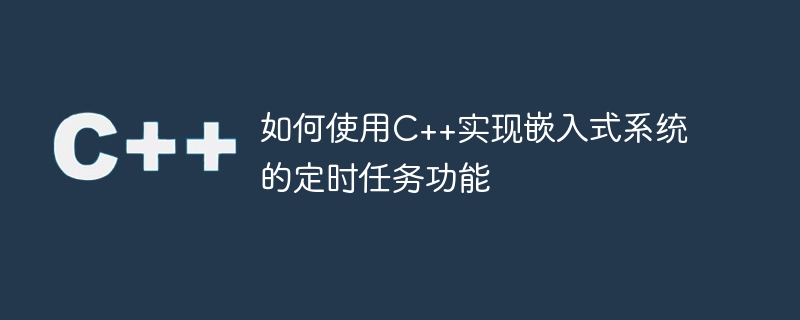Home >Backend Development >C++ >How to use C++ to implement the scheduled task function of embedded systems
How to use C++ to implement the scheduled task function of embedded systems
- 王林Original
- 2023-08-27 12:05:051109browse

How to use C to implement the scheduled task function of embedded systems
In embedded systems, it is often necessary to implement the scheduled task function, that is, to execute some tasks within a specific time interval. . C, as a powerful programming language, provides us with many tools and libraries to achieve such functions. This article will introduce how to use C programming language to implement scheduled task functions in embedded systems and provide some code examples.
- Using timer interrupts
In embedded systems, we can use timer interrupts to implement scheduled task functions. By setting the count value and interrupt interval of the timer, when the timer reaches the set interrupt value, an interrupt will be triggered and the corresponding interrupt processing function will be executed.
The following is a code example that uses C to implement scheduled tasks:
#include <iostream>
#include <thread>
#include <chrono>
void task()
{
// 定时任务的具体操作
std::cout << "定时任务执行" << std::endl;
}
void timerInterrupt()
{
while (true)
{
// 设置中断间隔为1秒
std::this_thread::sleep_for(std::chrono::seconds(1));
// 调用定时任务
task();
}
}
int main()
{
// 开启计时器中断线程
std::thread t(timerInterrupt);
// 主线程继续执行其他操作
// ...
// 等待计时器中断线程结束
t.join();
return 0;
}In the above code, we used the <thread></thread> library and library to implement the scheduled task function. In the timerInterrupt() function, we use std::this_thread::sleep_for(std::chrono::seconds(1)) to set the interrupt interval to 1 second. When the time reaches 1 second, the task() function will be executed.
- Using the timer library
In addition to using timer interrupts, we can also use the timer library to implement scheduled task functions. The timer library can manage scheduled tasks more conveniently and provides more functions and options.
The following is a code example that uses the C timer library to implement scheduled tasks:
#include <iostream>
#include <chrono>
#include <timer>
void task()
{
// 定时任务的具体操作
std::cout << "定时任务执行" << std::endl;
}
int main()
{
// 创建一个定时器对象,设置定时任务的执行间隔为1秒
Timer timer(std::chrono::seconds(1), task);
// 启动定时器
timer.start();
// 主线程继续执行其他操作
// ...
// 等待定时器关闭
timer.stop();
return 0;
}In the above code, we use the C timer library to implement the scheduled task function. First, we create a timer object timer, and set the execution interval of the scheduled task to 1 second through std::chrono::seconds(1), and specify the function of the scheduled task is task(). Then, we call timer.start() to start the timer, and the scheduled task will be executed cyclically within the set interval. Finally, we call timer.stop() to stop the timer.
Summary:
Through timer interrupts or using the timer library, we can easily implement the scheduled task function in embedded systems. Whether using timer interrupts or timer libraries, C provides us with powerful programming tools and library functions to simplify the implementation of scheduled tasks. I hope the code examples in this article are helpful to you. If you have any questions, please leave a message for discussion.
The above is the detailed content of How to use C++ to implement the scheduled task function of embedded systems. For more information, please follow other related articles on the PHP Chinese website!
Related articles
See more- How Laravel prevents your scheduled tasks from being executed repeatedly
- Scheduled tasks under Linux - scheduled tasks that are executed only once
- Is linux an embedded system?
- How to use C++ to build efficient and reliable embedded system interactive applications
- How to use C++ to implement low-power standby function of embedded systems

